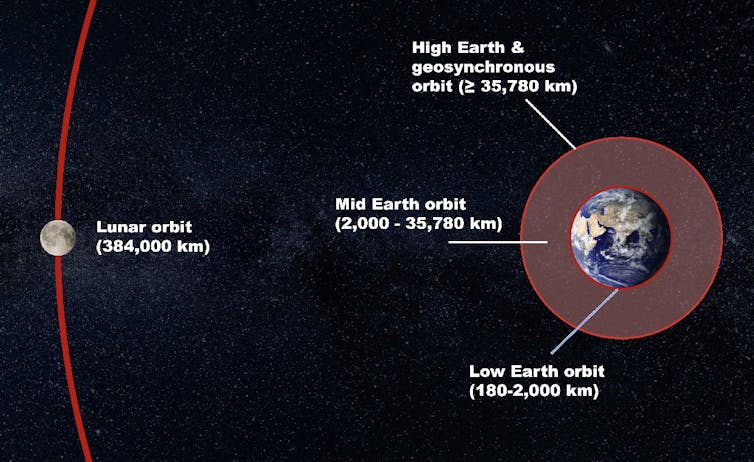Reports this week suggest a near-collision between an Australian satellite and a suspected Chinese military satellite in space.
Meanwhile, earlier this month, the U.S. government issued the first-ever space junk fine. The Federal Communications Commission handed a US$150,000 penalty to the DISH Network, a publicly traded company providing satellite TV services.
It came as a surprise to many in the space industry, as the fine didn’t relate to any recent debris — it was issued for a communications satellite that has been in orbit for more than 21 years. It was EchoStar-7, which failed to meet the orbit requirements outlined in a previously agreed debris mitigation plan.
The EchoStar-7 fine might be a U.S. first, but it probably won’t be the last. We are entering an unprecedented era of space use and can expect the number of active satellites to increase by 700 percent by the end of the decade.
As our local space gets more crowded, keeping an eye on tens of thousands of satellites and bits of junk will only become more important. So researchers have a new field for this: space domain awareness.
Three types of orbit, plus junk
Humans have been launching satellites into space since 1957 and in the past 66 years, have become rather good at it. There are currently more than 8,700 active satellites in various orbits around Earth.
Satellites tend to be in three main orbits, and understanding these is key to understanding the complex nature of space debris.

The most common orbit for satellites is low Earth orbit, with at least 5,900 active satellites. Objects in low Earth orbit tend to reside up to 1,000 km above Earth’s surface and are constantly on the move. The International Space Station is an example of a low Earth orbit object, traveling around Earth 16 times every day.
Higher up is the medium Earth orbit, where satellites sit between 10,000 and 20,000 km above Earth. It’s not a particularly busy place, but is home to some of the most important satellites ever launched — they provide us with the global positioning system, or GPS.
Finally, we have very high-altitude satellites in geosynchronous orbit. In this orbit, satellites are upwards of 35,000 km above Earth, in orbits that match the rate of Earth’s rotation. One special type of this orbit is a geostationary Earth orbit. It lies on the same plane as Earth’s equator, making the satellites appear stationary from the ground.
As you can tell, Earth’s surroundings are buzzing with satellite activity. It only gets more chaotic when we factor in space junk, defined as disused artificial debris in orbit around Earth.
Space junk can range from entire satellites that are no longer in use or working, down to millimeter-wide bits of spacecraft and launch vehicles left in orbit. Latest estimates suggest there are more than 130 million pieces of debris, with only 35,000 of those large enough (greater than 10cm) to be routinely tracked from the ground.
How do we track them all?
This is where space domain awareness comes in. It is the field of detecting, tracking, and monitoring objects in Earth’s orbit, including active satellites and debris.
We do much of this with ground-based tracking, either through radar or optical systems like telescopes. While radar can easily track objects in low Earth orbit, higher up, we need optical sensors. Objects in medium Earth orbit and geostationary orbit can be tracked using sunlight reflected toward Earth.
For reliable and continuous space domain awareness, we need multiple sensors contributing to this around the globe.
Below you can see what high-altitude satellites can look like to telescopes on Earth, appearing to stay still as the stars move by.
Australia’s role in space awareness
Thanks to our position on Earth, Australia has a unique opportunity to contribute to space domain awareness. The U.S. already houses several facilities on the west coast of Australia as part of the Space Surveillance Network. That’s because, on the west coast, telescopes can work in dark night skies with minimal light pollution from large cities.

Furthermore, we are currently working on a space domain awareness technology demonstrator (a proof of concept), funded by SmartSat CRC. This is a government-funded consortium of universities and other research organizations, along with industry partners such as the IT firm CGI.
We are combining our expertise in observational astrophysics, advanced data visualization, artificial intelligence, and space weather. Our goal is to have technology that understands what is happening minute by minute. Then, we can line up follow-up observations and monitor the objects in orbit. Our team is currently working on geosynchronous orbit objects, which include active and inactive satellites.
EchoStar-7 was just one example of the fate of a retired spacecraft — the FCC is sending a strong warning to all other companies to ensure their debris mitigation plans are met.
Inactive objects in orbit could pose a collision risk to each other, leading to a rapid increase in space debris. If we want to use Earth’s space domain for as long as possible, we need to keep it safe for all.
Acknowledgment: The authors would like to thank Sholto Forbes-Spyratos, military space lead at CGI Space, Defence and Intelligence Australia, for his contribution to this article.
Sara Webb, Postdoctoral Research Fellow, Centre for Astrophysics and Supercomputing, Swinburne University of Technology; Brett Carter, Associate Professor, RMIT University, and Christopher Fluke, SmartSat Professorial Chair, Swinburne University of Technology
This article is republished from The Conversation under a Creative Commons license. Read the original article.
Follow us on X, Facebook, or Pinterest

